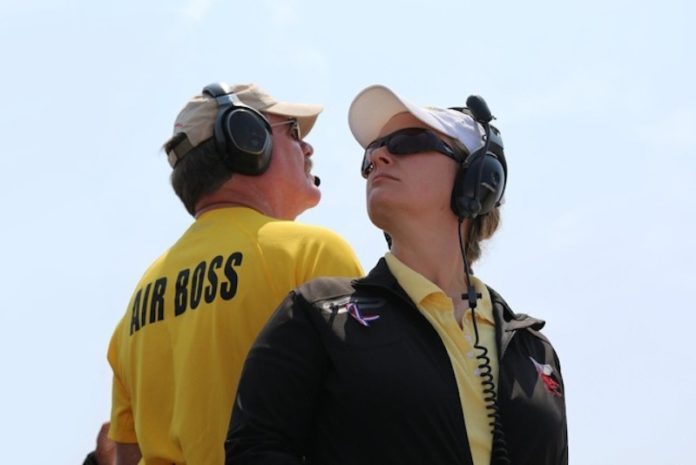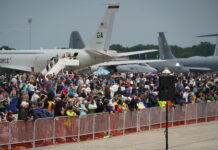At nearly every North American air show, there will be one person who has ultimate responsibility for the overall safety of the air show. There are many different labels associated with this role, but the industry standard is: air boss.
There are a myriad of definitions and perceived responsibilities associated with the title air boss; however, for clarity in this discussion, we will define an air boss as the person who administers the activities forward of the crowd line at an air show on practice and show days. The air boss leads the safety briefing and executes real time deconfliction of performances and in air performers.
In the barnstorming days, the air boss-type responsibilities were handled by the most experienced pilot talking to the other pilots on a two-way radio. Today, the air boss is, effectively an air show air traffic controller charged with mitigating risks from a designated control point. These changes have been made possible, in part, by improvements in and better access to technological capabilities (stronger radios, smaller portable weather equipment), but they are largely due to increased demands on and more significant expectations of air bosses.
If it seems like there has been a greater focus on and more discussion about air bosses during the last few years, that’s because there is a clearer understanding that they stand at the intersection of virtually all safety-related issues at a typical air show. Air bosses no longer deconflict issues between a couple of slow-speed barnstormers; rather, they must work out takeoff and landings, aerobatic box entry and exit times, and emergency procedures between aircraft as vastly different as a slow and small Piper Cub and a big and fast F/A-18 Hornet. Having potentially dozens of aircraft in the air at the same time demands better line of sight, improved communications capabilities, and ability to rapidly respond to real time hazards. This increased workload and greater responsibility has developed in just the last few years. And it makes it especially important that air shows select the air bosses that they use for their shows very carefully and deliberately.
In the airline segment of our industry, the demands on and expectations of air traffic controllers have constantly changed and evolved since the inception of the national air space system. The time has come for the air show industry to match suit. Where a two-way radio and an aviation background may have been enough in the past, modern day air shows have progressed to a point where they need an experienced, dedicated professional to fill the role of air boss.
Since the air show community — and ICAS in particular — began instituting a safety management system (SMS) in 2008, the goal of this program has been to preemptively determine hazards and to take steps to mitigate these hazards from becoming incidents. There is a safety tool known as Reason’s Model which diagrams the chain of events that take place in order for an accident to happen. More commonly referred to as the “Swiss Cheese Model,” Reason’s model explains that accidents happen due to “holes” in various layers of active defenses. Periodically, these “holes” or lapses in the safety program line up just right and an accident occurs.
What does this mean for your air show? This is a particularly difficult question to answer as there may be a dozen different responses to a dozen different air shows. However, concerns have been raised to both the ICAS office and to members of the air show community at large that deficiencies among air bosses have played a factor in several near miss incidents in recent years. For example, an air boss who cleared an airliner to land in the aerobatic box while a performer was performing aerobatics. In another case, a jump plane was on final approach to land while another performer was practicing his aerobatic routine after a less-than-adequate briefing. Or an air boss who allowed a pilot to fly an aerobatic sequence during the air show waiver with a passenger. And these are just some examples of deficiencies displayed by air bosses in recent years.
The common thread among all of these issues is that the air boss was under-qualified or inexperienced. Air bosses that work as an air boss for just one show are more numerous than professional air bosses; however, there is a trade-off to be made when selecting a “local” air boss over a professional. Professional air bosses provide a wealth of knowledge developed over years of experience…the kind of practical learning that can only be gained through the exposure to multiple show sites each year. While an argument could be made that a local volunteer has a better understanding of the specific needs of a show, the potential sacrifices made by using a local air boss often outweigh any cost that would be incurred by hiring a professional with years of experience at hundreds of air shows.
There are, of course, exceptions to this general rule. Some shows, for example, have instituted an apprentice program that extends over many years to ensure that their air bosses have significant training and experience before they run their first event. But this option is often impractical for many shows as it requires advanced planning that is measured in years.
What are the other options? There are a number. ICAS offers an Air Boss Academy for prospective air bosses each year in which a two-day ground course is supplemented with real time observations of an air boss during an air show. Additionally, the Air Boss 201 session at the ICAS convention provides a day long learning experience during which seasoned air bosses pass along their knowledge. Most experienced air bosses are amenable to being “shadowed” by an air boss-in-training to get an up-close look at the mechanics, tactics and standard operating procedures for air bossing.
The United States Air Force Air Combat Command (ACC) has been made aware of potential issues of inexperienced air bosses. Single ship demonstration pilots and senior members of ACC will be meeting with industry professionals to assess this situation at the ICAS Convention in December. The Federal Aviation Administration has also started asking questions about air bosses and air boss training.
It is time for us as an industry to recognize and embrace the changes needed to ensure that all of our industry’s air bosses are not just enthusiastic, but competent and capable of mitigating the potential hazards associated with using less experienced air bosses. If adding a comparatively minor air boss line item to your annual budget will help to improve safety and confidence at your event, you may find this to be a relatively easy and inexpensive way to put “Safety First.”








